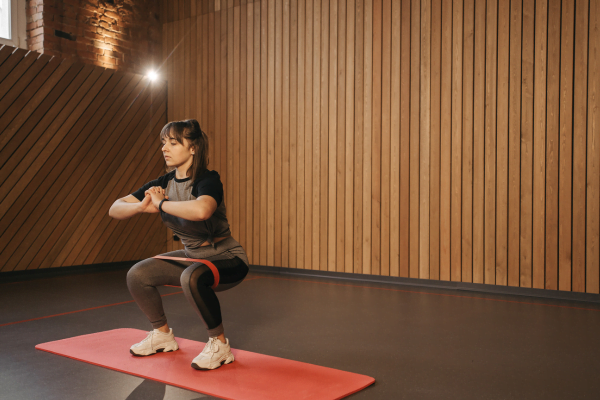Exercise, unlike popular misconception, is not synonymous with physical activity, but it is a component of physical activity.
Physical activity is a kind of body movement produced by the skeletal muscles that helps burn calories. On the other hand, exercise is a planned, structured, purposeful, repetitive physical activity that helps in the expenditure of energy. For example, daily chores, household, and occupational tasks can be regarded as physical activities, whereas swimming or hitting the gym is a type of exercise.
What are the components of physical fitness?
The 5 components of physical fitness are:
- Cardiorespiratory endurance
- Muscular endurance
- Muscular strength
- Body composition
- Flexibility
What is exercise resistance?
One can reap the benefits of exercise and lose it shortly after a period of inactivity. If your only source of physical activity of the day is your scheduled exercise session and you remain sedentary in the remaining hours of the day, your body does not burn fat but more fat stores are accumulated. This is called exercise resistance.
The 2 benefits of exercise-related cardiorespiratory endurance are:
- Improved postprandial hypertriglyceridemia (a risk factor for cardiovascular disease)
- Improved glucose tolerance
Exercise resistance can hinder these benefits of exercise.
- Postprandial hypertriglyceridemia
Sitting for long hours has become the norm due to occupational hazards both before and after meals.
Post-meals, the triglyceride levels can remain high for a duration of approximately 10 hours, with peaks between 3-6 hours, especially after a high-fat meal. The intensity and duration of this peak can be determined by previous physical activities performed, genetics, and the type of diet consumed.
Several studies show that being inactive or sitting for a long time can increase the negative health risk factors such as
- Increased risk of obesity.
- Metabolic disorders (Type 2 diabetes mellitus, cardiovascular risk factors, etc.).
- Death
The risks of long sitting hours are not dependent on the duration of exercise performed but directly influence cardiovascular diseases and mortality.
A study conducted to understand the effect of prolonged sitting on health revealed that only 2-4 days of long sitting hours of approximately 14 hours/day resulted in postprandial hypertriglyceridemia when compared to being physically active by walking or standing. Being in a state of energy balance or having a hypocaloric diet did not have any influence on the individuals who were studied for long sitting hours.
Inactivity can also be defined as any activity with an activity such as sitting or reclining position with a ≤1.5 metabolic equivalent. This increases the mortality rate by a massive 1.5–6 fold.
Another study was conducted with 10 healthy participants (5 men and 5 women) who were physically active on a daily basis. 2 trials were conducted to understand the effect of multiple days of long sitting hours (>13 hours) with low activity levels. The finding was that long sitting hours with low step count or 1 hour of daily high-intensity exercise did not help with glucose tolerance or postprandial hypertriglyceridemia. There was no improvement in cardiometabolic risk factors. This lack of improvement of normal metabolic effects of acute activity is called resistance exercise.
- Insulin sensitivity
Creating an energy balance between energy intake and energy expenditure is considered an essential paradigm. However, recent studies suggest that daily exercise and being in a state of calorie deficit are not sufficient, and long sedentary time is a risk factor in itself.
A study was conducted on 18 healthy young individuals (age 21±2 years, BMI 22.6±2.6 kg/m2). The participants were divided and asked to follow 3 regimes for 4 days:
- Regimen 1: Sit 14 hours a day (daily energy expenditure was 500 kcal less than the other 2 regimes).
- Regimen 2: Sit 13 hours a day + 1 hour of vigorous activity.
- Regimen 3: Sit for 8 hours + 4 hours of walking + 2 hours of standing.
The findings revealed:
Exercise regimen | Daily energy expenditure | Insulin sensitivity | Blood lipids |
Regimen 1 |
Lowest |
Worst |
Worst |
|
|
|
|
|
|
|
|
- Sarcopenia
Apart from the negative impact that exercise resistance has on triglyceride levels and insulin sensitivity, its effect on muscle mass is also not uncommon. Sarcopenia is age-related muscle loss in individuals. Muscle loss occurs yearly between 1-3%. Sarcopenia can occur when the rate of degradation is greater than synthesis.
Studies conducted with a gradual reduction in step count among young males support the fact that long periods of muscle inactivity can affect muscle metabolism. Especially in the elderly, the myo-fibrillar contraction is less when the daily step count is approximately 1400 steps a day due to muscle disuse. Overweight and older individuals who are pre-diabetic are less likely to recover from muscle disuse due to exercise resistance.
In such cases, the general exercise recommendations are not effective and do not promote health benefits.
Exercise resistance vs. Resistance exercise
Exercise resistance | Resistance exercise |
This is a rare phenomenon due to long bouts of inactivity such as sitting or lying down. The body becomes inefficient in metabolising fat though 1 hour of high-intensity activity is performed. | This is a form of exercise also known as strength training or weight training. It increases muscle strength by making the muscle groups work against a threshold. It is performed using body weight, resistance bands, dumbbells, etc. |
How do I overcome exercise resistance?
A sedentary lifestyle can be characterised by steps <5000 steps/day. According to a study, there is no fixed regime to overcome exercise resistance, here are some tips to follow if you feel you have exercise resistance:
- Practise a moderate-intensity activity for a duration of 1 hour + a minimum of 8500 steps/day.
- Break the monotony of long hours of sitting by cycling for 5 reps of 4 seconds each.
- Use an activity tracker or pedometer to help you track your step count or long periods of rest.
It is, however, important to follow general physical activity guidelines and a healthy diet, as well as the above suggestions provided to help improve exercise resistance.
General physical activity guidelines
The guidelines for adults of ages 19-64 years as provided by the National Health Services (NHS), England are:
- Practise strength training focusing on the major muscle groups (legs, hips, back, abdomen, chest, shoulders, arms) a minimum of 2 days a week.
- Practise 150 minutes of moderate-intensity activity/week or 75 minutes of high-intensity activity/week.
- Space out your exercise over a span of 4-5 days or daily.
- Move more throughout the day and avoid prolonged sitting or lying down.
Prolonged sitting is bad for your health. Taking time to practise one hour of physical activity is not sufficient to counteract the negative impact it has on health. If you feel you may have exercise resistance, it is important to speak to your doctor or physiotherapist to help understand the ways to tackle the same. By avoiding long durations of inactivity, you can benefit more than what you may gain from a single exercise session since the energy expended by your body is kept constant.
Mayuri,
Dietetic Researcher, Simplyweight





